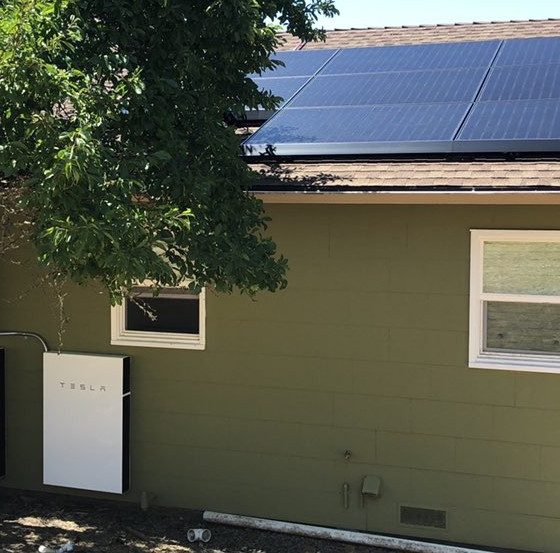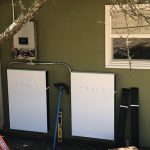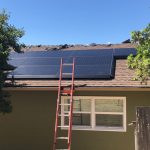

Energy
Tesla Energy’s quick installs hint at ongoing residential solar and Powerwall ramp
It appears that Tesla Energy’s highly-anticipated ramp is picking up some speed. With Model 3 production humming at levels that allow the company to begin distributing the all-electric sedans to international markets, the company seems to be intent in gaining back some momentum in the United States’ residential solar market, a segment that was, at one point, dominated by SolarCity.
Tesla Model 3 owner Nick Wood and his family had been looking to add solar panels and a home battery system to their house in Santa Rosa, CA. The home had been affected by the 2017 wildfires, and PGE had advised residents in the area that there will be power interruptions during windy, dry conditions. With the family being all-in on electric vehicles — a Tesla Model 3 and two Chevy Bolts under a lease — the Woods needed a way to achieve power independence from the grid.
The family filed applications for two projects: one for their main house with about 40 kW of solar panels and five Powerwall units, and another for a second house with 8.2 kW of solar and two Powerwalls. Both applications were filed around June 10. Following a site visit and once the loan terms and other financials of the project were approved, Tesla informed the family that the first Powerwall and solar panels were set to be installed on July 2. That was just over three weeks since the system was ordered.
@Tesla @elonmusk @ElectrekCo @Teslarati @ValueAnalyst1 Tesla solar easy as ordering a car 3 weeks from order to install, less than cost of power per month. Looks like 2 power walls and 26 panels will be installed in 1 day. Longer to get county/PGE sign off
— 🔋Nick Wood 🔋🚀🚀🚀 (@nick_waya) July 2, 2019
The Tesla installers arrived at around 9 a.m. on the day of the installation. The team worked simultaneously, with some working on trenches for the system’s power connections, others setting up the Powerwalls, and the rest installing the solar panels. Much to the Woods’ appreciation, the entire project was fully completed before the end of the day. The team even set up two electric car chargers at no extra cost. The Tesla team also gave the Woods their email addresses so that they could forward any pertinent information about the site to the installers of the main house’s upcoming 40 kW solar panels and five Powerwalls.
In a message to Teslarati, Nick Wood mentioned that the installers had been finishing around one Tesla Energy project per day. The installers also stated that they have been particularly busy as of late, with an appointment with a residential solar and/or Powerwall customer being scheduled daily. Quite notably, Wood stated that his family now has to wait around 1-5 weeks for the county inspection so that they can activate the system. That’s potentially longer than the time it took for the solar panels and Powerwalls to be ordered and installed.
- A Tesla Solar and Powerwall 2 installation at Santa Rosa, CA. (Photo: Nick Wood)
- A Tesla Solar and Powerwall 2 installation at Santa Rosa, CA. (Photo: Nick Wood)
A Tesla Solar and Powerwall 2 installation at Santa Rosa, CA. (Photo: Nick Wood)
Granted, part of the reason behind the quick turnaround time of the Woods’ residential solar installation could be their location. Being in California, the family lives in a state that is heavily saturated by Tesla. Nevertheless, the efficiency exhibited by the installers, as well as the team’s mention of busy weeks filled with project after project, hints at a ramp in the company’s Energy initiatives.
This bodes well for Tesla’s residential solar business, which has seen a decline since the company acquired SolarCity in 2016. Since SolarCity’s peak of commanding 32.6% of the US market in 2014, Tesla’s presence in the country’s residential solar segment as shrunk, hitting only 6.3% during Q1 2019. Nevertheless, hints of a potential ramp started emerging last year, when Tesla started dramatically reducing its customer acquisition costs by spending only $0.40 per watt to acquire customers. This is far lower than competitors such as Vivint, which has customer acquisition costs of $0.94 per watt, and Sunrun, whose costs run at $0.90 per watt.
Tesla Energy is pretty much a sleeping giant for now. The business has so far been away from the spotlight, especially amidst the production ramp of the Model 3, but it has a lot of potential. Legendary investor Ron Baron, for one, has estimated that Tesla Energy on its own could be worth $500 billion. Elon Musk and the company’s executives, for their part, have noted that a ramp in Tesla Energy’s activities is underway, with the CEO stating during the unveiling of the Model Y that 2019 will be the “Year of the Solar Roof and Powerwall.”

Cybertruck
Tesla updates Cybertruck owners about key Powershare feature

Tesla is updating Cybertruck owners on its timeline of a massive feature that has yet to ship: Powershare with Powerwall.
Powershare is a bidirectional charging feature exclusive to Cybertruck, which allows the vehicle’s battery to act as a portable power source for homes, appliances, tools, other EVs, and more. It was announced in late 2023 as part of Tesla’s push into vehicle-to-everything energy sharing, and acting as a giant portable charger is the main advantage, as it can provide backup power during outages.
Cybertruck’s Powershare system supports both vehicle-to-load (V2L) and vehicle-to-home (V2H), making it flexible and well-rounded for a variety of applications.
However, even though the feature was promised with Cybertruck, it has yet to be shipped to vehicles. Tesla communicated with owners through email recently regarding Powershare with Powerwall, which essentially has the pickup act as an extended battery.
Powerwall discharge would be prioritized before tapping into the truck’s larger pack.
However, Tesla is still working on getting the feature out to owners, an email said:
“We’re writing to let you know that the Powershare with Powerwall feature is still in development and is now scheduled for release in mid-2026.
This new release date gives us additional time to design and test this feature, ensuring its ability to communicate and optimize energy sharing between your vehicle and many configurations and generations of Powerwall. We are also using this time to develop additional Powershare features that will help us continue to accelerate the world’s transition to sustainable energy.”
Owners have expressed some real disappointment in Tesla’s continuous delays in releasing the feature, as it was expected to be released by late 2024, but now has been pushed back several times to mid-2026, according to the email.
Foundation Series Cybertruck buyers paid extra, expecting the feature to be rolled out with their vehicle upon pickup.
Cybertruck’s Lead Engineer, Wes Morrill, even commented on the holdup:
As a Cybertruck owner who also has Powerwall, I empathize with the disappointed comments.
To their credit, the team has delivered powershare functionality to Cybertruck customers who otherwise have no backup with development of the powershare gateway. As well as those with solar…
— Wes (@wmorrill3) December 12, 2025
He said that “it turned out to be much harder than anticipated to make powershare work seamlessly with existing Powerwalls through existing wall connectors. Two grid-forming devices need to negotiate who will form and who will follow, depending on the state of charge of each, and they need to do this without a network and through multiple generations of hardware, and test and validate this process through rigorous certifications to ensure grid safety.”
It’s nice to see the transparency, but it is justified for some Cybertruck owners to feel like they’ve been bait-and-switched.
Energy
Tesla starts hiring efforts for Texas Megafactory
Tesla’s Brookshire site is expected to produce 10,000 Megapacks annually, equal to 40 gigawatt hours of energy storage.

Tesla has officially begun hiring for its new $200 million Megafactory in Brookshire, Texas, a manufacturing hub expected to employ 1,500 people by 2028. The facility, which will build Tesla’s grid-scale Megapack batteries, is part of the company’s growing energy storage footprint.
Tesla’s hiring efforts for the Texas Megafactory are hinted at by the job openings currently active on the company’s Careers website.
Tesla’s Texas Megafactory
Tesla’s Brookshire site is expected to produce 10,000 Megapacks annually, equal to 40 gigawatt hours of energy storage, similar to the Lathrop Megafactory in California. Tesla’s Careers website currently lists over 30 job openings for the site, from engineers, welders, and project managers. Each of the openings is listed for Brookshire, Texas.
The company has leased two buildings in Empire West Business Park, with over $194 million in combined property and equipment investment. Tesla’s agreement with Waller County includes a 60% property tax abatement, contingent on meeting employment benchmarks: 375 jobs by 2026, 750 by 2027, and 1,500 by 2028, as noted in a report from the Houston Business Journal. Tesla is required to employ at least 1,500 workers in the facility through the rest of the 10-year abatement period.
Tesla’s clean energy boom
City officials have stated that Tesla’s arrival marks a turning point for the Texas city, as it highlights a shift from logistics to advanced clean energy manufacturing. Ramiro Bautista from Brookshire’s economic development office, highlighted this in a comment to the Journal.
“(Tesla) has great-paying jobs. Not just that, but the advanced manufacturing (and) clean energy is coming to the area,” he said. “So it’s not just your normal logistics manufacturing. This is advanced manufacturing coming to this area, and this brings a different type of job and investment into the local economy.”
Energy
Tesla and Samsung SDI in talks over new US battery storage deal: report
The update was related by industry sources and initially reported by South Korean news outlets.

Recent reports have suggested that Tesla and Samsung SDI are in talks over a potential partnership to supply batteries for large-scale energy storage systems (ESS).
The update was related by industry sources and initially reported by South Korean news outlets.
ESS batteries to be built at Samsung’s Indiana plant
As noted in a report from Korea JoongAng Daily, the demand for energy storage systems has been growing rapidly in North America, thanks in no small part to the surge in AI investments across numerous companies. With this in mind, Tesla has reportedly approached Samsung SDI about a potential battery supply deal.
The deal is reportedly worth over 3 trillion Korean won (approximately $2.11 billion) and will span three years, according to The Korea Global Economic Daily. A battery supply deal with Samsung SDI could make sense for Tesla as the company already has a grid-scale battery, the Megapack, which is perfect for industrial use. Samsung SDI could simply supply cells for the EV maker.
Production of the batteries would reportedly take place at Samsung SDI’s joint venture factory with Stellantis in Indiana, which is currently under construction. Samsung SDI recently announced plans to use part of that plant’s EV lines to produce cells for ESS, with a targeted capacity of 30 GWh by the end of next year.
Tesla and Samsung’s partnership
At present, only a handful of manufacturers, including Korea’s LG Energy Solution, Samsung SDI, SK On, and Japan’s Panasonic, are capable of producing energy storage-scale batteries domestically in the United States. A Samsung SDI official issued a comment about the matter, stating, “Nothing has been finalized regarding cooperation with Tesla.”
The possible energy storage system deal adds another layer to Tesla’s growing collaboration with Samsung, which is already in line as a partner in the upcoming production of Tesla’s AI5 and AI6 chips. Early sample manufacturing of the AI6 is expected to begin in South Korea, with mass production slated for Samsung’s Texas-based Taylor foundry when it starts operations.
The AI6 chip will power Tesla’s next wave of high-volume projects, including the Optimus humanoid robot and the autonomous Cybercab service. Musk has called the partnership with Samsung a “real collaboration,” adding that he personally plans to “walk the line” at the Taylor facility to speed up progress.










